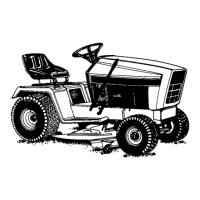
 Loading...
Loading...
Do you have a question about the Cub Cadet 1215 and is the answer not in the manual?
| fuel tank capacity | 3 gals |
|---|---|
| crankcase capacity | 3 pints |
| transmission capacity | 1-1/2 pints |
| transaxle capacity | 2-3/4 pints |
| gears | 5 forward speeds and 1 reverse |
|---|---|
| forward speed | 0 to 5.5 mph |
| reverse speed | 0 to 2.35 mph |
| engine make and model | Briggs and Stratton |
|---|---|
| engine power | 12 HP |
| cylinders | 1 |
| bore | 3.44 in |
| stroke | 3.06 in |
| displacement | 28.40 cubic inches |
| low speed | 1750 RPM |
| high idle speed | 3400 RPM +-100 |
| system voltage | 12 volt neg. ground |
|---|---|
| alternator | 16 amp |
| fuse | 20 amp slow blow |
| headlights | GE 12 volt 1156 |
| front tire size | 15x6-6 |
|---|---|
| rear tire size | 20x10-8 |
| wheelbase | 45.0 in |
| length | 68.50 in |
| turning radius | 29.00 in |